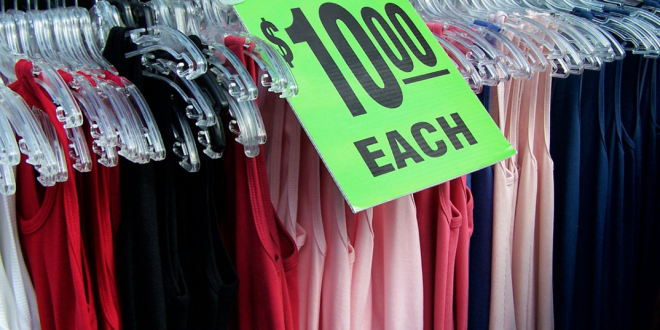By Kaitlyn Wang
Shoes worn only several times, forgotten dresses hanging in the closet, T-shirts that have barely seen the light of day—too often, clothes are purchased, then set aside and eventually discarded.
According to McKinsey & Company, the number of purchased clothes has increased by 60 percent between 2000 and 2014. But the clothes are kept for half as long.
Known as “fast fashion,” the rapid production of cheap, trendy clothes may seem to present benefits for consumers, feeding a buy, (barely) use, and toss mentality. But beneath the apparent comfort and convenience of affordable, readily available apparel, there exist serious consequences regarding human rights and the environment.
Mass-production results in lowered clothing prices, according to an article by NPR. And as new trends and styles develop, the demand for more clothes grows, while those no longer “in fashion” end up in the landfill—or overseas.
Although people may think the clothes they donate to The Salvation Army and Goodwill help nearby people in need, that is not always the case. Because of the sheer number of garments they receive, these organizations turn to other countries, including countries in East Africa, according to The Washington Post.
Exports of secondhand clothes harm local clothing industries, an article by The New York Times reported. With a large volume of unwanted clothes entering a country, it becomes difficult for the manufacturers there to compete. Now, East African countries, such as Rwanda and Kenya, are striving to enact bans on imported used clothing, but they face opposition from the United States.
It is time to stop pushing the discarded and unwanted upon developing countries. It is time to face the responsibility of manufacturing and buying and using and discarding without thought for the future.
The production of cheap clothes damages human health as well as the economy, as workers labor for hours for little pay in hazardous conditions. The materials they work with are unsafe, including leather.
Leather requires water, land, animal feed, and fossil fuels for production, resulting in water and atmospheric pollution. Communities where tanning processes are located face severe health consequences; production leads to an approximate 20-50 percent greater probability of cancer in leather tannery workers, reports The True Cost. The True Cost is a documentary that explores the “true cost” of the fashion industry—a price that people and the environment cannot afford.
Another harmful material is cotton. National Geographic reports that one cotton shirt requires 2,700 liters of water: the amount of water a person can drink in two and a half years.
In addition to water, cotton also uses large amounts of pesticides. Out of global insecticide use, 25 percent is attributed to the production of cotton, according to The True Cost. Chemicals, the health consequences of which are largely unknown, may pose dangers to human health and the environment people are not yet aware of.
Thrift shopping is one way to purchase used clothes instead of contributing to the demand for newly manufactured garments. There is also the app Good on You, which provides information about how ethical it is to shop certain brands based on their impact on people, animals and the environment.
Although it may seem difficult for an individual to combat the overwhelming issue of fast fashion, individual choices do matter. Instead of reaching for a pair of jeans, a T-shirt, or a dress on sale, it is crucial to look past the price tag. What is the real cost of clothing? Consider who made the clothes, how they are made, and how the tendency to buy then discard hurts people and the environment.
And as a NPR article asks, “What’s your waste size?”
Sources
https://truecostmovie.com/learn-more/environmental-impact/
https://www.nytimes.com/2017/10/12/world/africa/east-africa-rwanda-used-clothing.html
https://www.npr.org/2016/04/08/473513620/what-happens-when-fashion-becomes-fast-disposable-and-cheap
http://www.wri.org/blog/2017/07/apparel-industrys-environmental-impact-6-graphics
 Tempus Magazine By Students, For Students
Tempus Magazine By Students, For Students 



